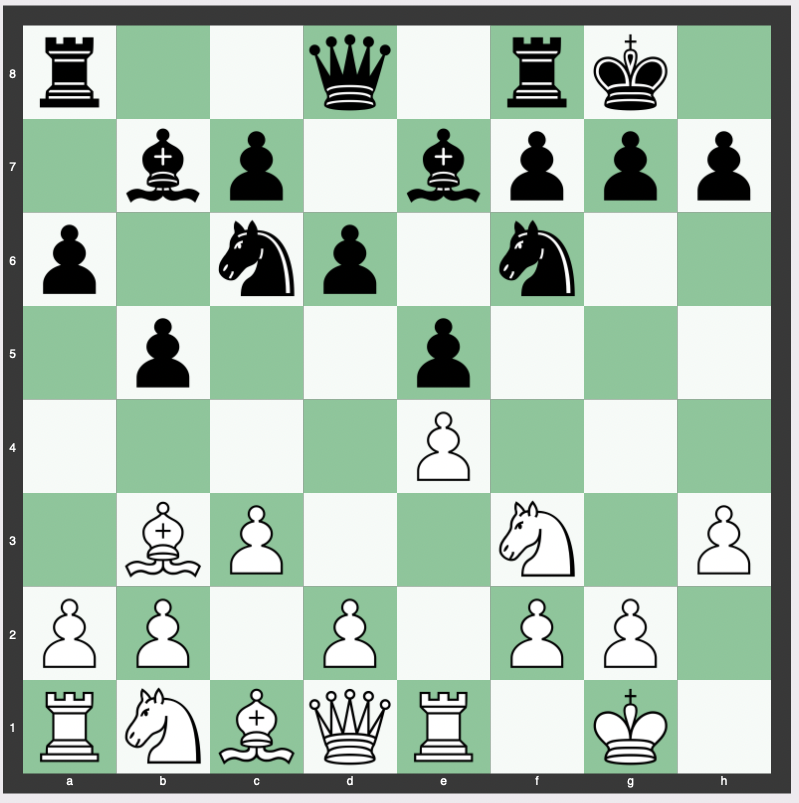The Zaitsev Variation, also known as the Flohr–Zaitsev Variation or Flohr System, is a complex and intriguing line in the Ruy Lopez, one of the oldest and most known chess openings.
It has been a favorite of many top players, including Anatoly Karpov, and has been the subject of extensive analysis and theory.
Below we look into the move order, theory, strategy, and purpose of this variation, as well as its history, suitability for different levels of players, and its frequency of play at the grandmaster level.
Move Order of the Zaitsev Variation of the Ruy Lopez
The Zaitsev Variation follows the sequence: 1. e4 e5 2. Nf3 Nc6 3. Bb5 a6 4. Ba4 Nf6 5. O-O Be7 6. Re1 b5 7. Bb3 d6 8. c3 O-O 9. h3 Bb7.

This move order leads to a rich and complex middlegame, with many tactical possibilities for both sides.
Theory, Strategy and Purpose of the Zaitsev Variation
The main idea behind the Zaitsev Variation is to put pressure on White’s central pawn on e4.
With 9…Bb7, Black prepares to increase this pressure after 10.d4 Re8 11.Nbd2 Bf8.
The resulting positions can become very sharp and tactical, offering chances for both sides.
One drawback of this line, if Black is playing for a win, is that White can force a draw by repetition with 11.Ng5 Rf8 12.Nf3.
Sub-Variations of the Zaitsev Variation
The Zaitsev Variation can lead to numerous sub-variations, depending on the choices made by both players.
The theory in this line extends beyond the middlegame, and the complexity of the resulting positions has led to extensive analysis and study.
Understanding the nuances of these variations requires deep knowledge and preparation.
The best reply for white is 4.d4.
Evaluation of the Zaitsev Variation
The evaluation of the Zaltsev Variation is around +0.40, providing some advantage for white.
Continuation Lines in the Zaltsev Variation
Sample continuation lines in the Zaltsev Variation include:
10. d4 Re8 11. Nbd2 Bf8 12. a4 h6 13. d5 Nb8 14. axb5 axb5 15. Rxa8 Bxa8 16. Nf1 c6 17. N3h2 Nbd7 18. Ng4 Nxg4 19. hxg4 cxd5 20. exd5 Bb7 21. Bc2
10. d4 Re8 11. Nbd2 Bf8 12. a4 h6 13. d5 Nb8 14. axb5 axb5 15. Rxa8 Bxa8 16. Nh2 c6 17. Ng4 Nbd7 18. Nf1 Nxg4 19. hxg4 g6 20. Be3 Bb7 21. Ng3 Qh4 22. Qf3 c5 23. c4
10. d4 Re8 11. Nbd2 Bf8 12. a4 h6 13. d5 Nb8 14. axb5 axb5 15. Rxa8 Bxa8 16. Nh2 c6 17. Ng4 Nbd7 18. Nf1 Bb7 19. dxc6 Bxc6 20. Qf3 Nc5 21. Ba2 h5 22. Nxf6+ Qxf6 23. Qxf6 gxf6 24. Bd5
10. d4 Re8 11. Nbd2 Bf8 12. a4 exd4 13. cxd4 h6 14. Bc2 Nb4 15. Bb1 bxa4 16. Qxa4 a5 17. Ra3 g6 18. e5 dxe5 19. dxe5 Nfd5 20. Ne4 Bg7 21. Qb5 Bc6 22. Qc5 Qe7 23. Rxa5 Qxc5 24. Rxc5
History of the Zaitsev Variation
The Zaitsev Variation was advocated by Igor Zaitsev, one of Karpov’s trainers for many years.
It quickly became a favorite of Karpov and has remained one of the most important variations of the Ruy Lopez.
Its popularity has waxed and waned over the years, but it continues to be a vital part of chess opening theory.
Karpov played in the Zaitsev Variation in the famous Game 20 of the 1990 World Chess Championship won by Garry Kasparov.
Kasparov’s Calculations – Mindboggling!!! (very instructive)
Is the Zaitsev Variation Good for Beginners or Intermediates?
The Zaitsev Variation is considered to be more suitable for intermediate and advanced players due to its complexity and the need to remember a lot of theory.
Beginners may find the sharp and tactical nature of this line challenging to navigate without a solid understanding of the underlying principles.
How Often Is the Zaitsev Variation Played at the Grandmaster Level?
While the Zaitsev Variation was once a popular choice at the grandmaster level, it is rarely seen at the top levels today.
The extensive theory and the possibility of forced draws in certain lines have led to a decline in its popularity among elite players.
However, it remains a viable option for those willing to invest the time and effort to master its intricacies.
Ruy Lopez: Zaitsev – Flohr variation
Conclusion
The Zaitsev Variation of the Ruy Lopez is a rich and complex opening that offers a wealth of strategic and tactical possibilities.
While it may not be suitable for beginners, intermediate and advanced players can find great value in studying this line.
Though its popularity at the grandmaster level has diminished, the Zaitsev remains a fascinating and important part of chess opening theory, reflecting the depth and beauty of the game itself.


